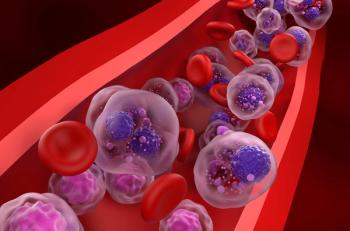
Oncology Overview: Niraparib
Niraparib is associated with increased progression-free survival, regardless of the presence or absence of BRCA gene mutations.
Niraparib (Zejula; GlaxoSmithKline) is an oral poly (ADP-ribose) polymerase (PARP) inhibitor approved in adult patients with ovarian cancer in addition to fallopian tube and primary peritoneal cancers.1
Whereas the mainstay of treatment for newly diagnosed advanced epithelial ovarian cancer involves surgery and platinum-taxane chemotherapy, up to 85% of patients with advanced ovarian cancer will have disease recurrence after treatment.2 In these patients, niraparib is associated with increased progression-free survival (PFS), regardless of the presence or absence of BRCA gene mutations.2
Indications and Dosage
Niraparib is indicated as:1
- First-line maintenance therapy for either advanced or recurrent ovarian, fallopian tube, or primary peritoneal cancer who are in complete or partial response to platinum-based chemotherapy.
- Primary treatment for advanced ovarian, fallopian tube, or primary peritoneal cancer in patients who meet the following criteria:
- Have been treated with 3 or more prior chemotherapy regimens.
- Have cancer associated with homologous recombinant deficiency-positive status (defined by either a deleterious BRCA gene mutation or genomic instability accompanied by disease progression more than 6 months after response to the last platinum-based chemotherapy).
- Providers must use an FDA-approved companion diagnostic for niraparib to identify eligible patients.1,3
Table 1 provides niraparib dosing based on indication.1
Patients may take niraparib with or without food. For adverse events (AEs), patients should consider interruption of treatment, dose reduction, or dose discontinuation.1 The package insert provides additional information on these dosage modifications.1
The dose of niraparib for patients with hepatic impairment is 200 mg by mouth once daily.1
Mechanism of Action
Niraparib exerts genotoxic activity by targeting rapidly dividing cells.4 It inhibits the enzymes PARP1 and PARP2, interfering with DNA repair by causing single- and subsequently double-stranded DNA breaks, which leads to programmed tumor cell death.1,5
FDA Approval
The FDA approved niraparib in March 2017 following the phase 3 NOVA trial, which compared niraparib with placebo in 2 independent cohorts (consisting of 553 enrolled patients), based on BRCA mutation status.4,6
The study evaluated progression-free survival as the primary endpoint.4 Niraparib was associated with a significantly longer median duration of PFS compared to the placebo group, regardless of the patient’s BRCA mutation or HRD status (21 vs. 5.5 months in the BRCA cohort, 12.9 vs 3.8 months in the non-BRCA, HRD-deficient cohort, and 9.3 vs. 3.9 months in the overall non-BRCA cohort).4,6
AEs
Table 2 provides niraparib’s most common adverse reactions (incidence of 10% or more).1
Pregnancy and Lactation
Niraparib can result in fetal harm in pregnancy by causing teratogenicity and/or embryo-fetal death due to its disruption of cell division.1 Similarly, health care providers should advise lactating women not to breastfeed during treatment with niraparib and for 1 month after receiving the final dose because of its risk to a breastfed child.1
About the Author
Lisa E Ruohoniemi, PharmD, is a Clinical Staff Pharmacist at LewisGale Hospital, Montgomery Blacksburg, VA.
References
- Zejula. Prescribing information. GlaxoSmithKline; 2021. Accessed November 2nd, 2021.
https://gskpro.com/content/dam/global/hcpportal/en_US/Prescribing_Information/Zejula_Capsules/pdf/ZEJULA-CAPSULES-PI-PIL.PDF - González-Martín A, Pothuri B, Vergote I, et al. Niraparib in Patients with Newly Diagnosed Advanced Ovarian Cancer. N Engl J Med. 2019;381(25):2391-2402. doi:10.1056/NEJMoa1910962
- Moore KN, Secord AA, Geller MA, et al. Niraparib monotherapy for late-line treatment of ovarian cancer (QUADRA): a multicentre, open-label, single-arm, phase 2 trial [published correction appears in Lancet Oncol. 2019 May;20(5):e242]. Lancet Oncol. 2019;20(5):636-648. doi:10.1016/S1470-2045(19)30029-4
- Ison G, Howie LJ, Amiri-Kordestani L, et al. FDA Approval Summary: Niraparib for the Maintenance Treatment of Patients with Recurrent Ovarian Cancer in Response to Platinum-Based Chemotherapy. Clin Cancer Res. 2018;24(17):4066-4071. doi:10.1158/1078-0432.CCR-18-0042
- About Zejula. GlaxoSmithKline.
https://www.zejulahcp.com/what-is-zejula/ . Accessed November 2021. - Mirza MR, Monk BJ, Herrstedt J, et al. Niraparib Maintenance Therapy in Platinum-Sensitive, Recurrent Ovarian Cancer. N Engl J Med. 2016;375(22):2154-2164. doi:10.1056/NEJMoa1611310
Newsletter
Stay informed on drug updates, treatment guidelines, and pharmacy practice trends—subscribe to Pharmacy Times for weekly clinical insights.






































































































































































































